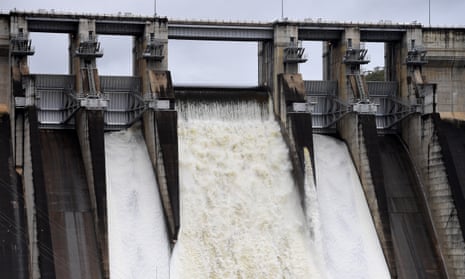The New South Wales flood inquiry has stopped short of recommending raising the Warragamba Dam wall, listing the $2bn-plus project as just one option governments have to reduce flood risks in Sydney’s Hawkesbury-Nepean valley.
The inquiry’s report, released on Wednesday by the state government, identified pros and cons of raising the wall of Sydney’s main source of drinking water by 14 metres. The project was not one of its 28 recommendations.
Instead, it was referred to as a “conundrum”. While Infrastructure NSW had assessed the project as “the single most effective flood mitigation option available”, the report also noted other objections to the proposal.
These included the impacts on “highly significant Aboriginal sites” and 88 threatened and endangered flora and fauna species if the world heritage-listed upper catchment were to be subjected to intermittent flooding behind a higher dam wall.
The project could also “lull communities into thinking new developments are safe from a large flood when they are not”, the report said.
Plans to raise the dam wall have been circulating since the 1990s when they were ruled out by then premier Bob Carr. The capital cost has tripled from $695m when the project was revived in 2016, and funding was not included in the state’s 2022 budget. Adding costs for offsetting environmental and cultural damage would further swell the tab.
The dam’s catchment has historically contributed between 40% and 70% of flood flows in the Hawkesbury-Nepean flood plain. Other measures to reduce flood risks include improving the road network to ease evacuation.
“Raising the Warragamba Dam wall is predicted to provide a significant reduction in current risks to life and property on a regional scale by holding back floodwaters, delaying peak flows and improving evacuation effectiveness,” it said.
On present forecasts, the number of people living and working in the valley will rise from 150,000 now to 257,000 by 2041. Modelling indicates a flood with a 1% chance of happening in any year would require more than 55,000 people to evacuate today.
By 2041, a flood with a 1 in 500 chance – equivalent to the 1867 record event – would force 135,000 people to evacuate, with 23,700 unlikely to be able to leave with the current road network. “Climate change modelling points to at least a doubling of the risk by 2041,” the report said.
The NSW premier, Dominic Perrottet, conceded on Wednesday that “there’s no specific recommendation” in the report about the dam wall.
“Having said that, it has a strong finding in relation to the positive impact raising the Warragamba Dam wall would have in terms of downstream flooding in those communities,” Perrottet told reporters in Lismore, the flood-hit northern NSW town.
“We’ll continue to work with the commonwealth government in relation to a cost-sharing arrangement on raising the Warragamba Dam wall,” he said. “It’s very clear to me, as you’ll see in this report, that [the project] will have a substantial impact on those communities downstream.”
For its part, Labor wants to amend Warragamba’s operating rules so it can lower the height of the water behind the existing wall, giving it “airspace” to absorb sudden inflows.
“My concerns about raising the wall remain that the price of lifting it has doubled in the last few years without any work beginning, and is potentially a decade away from being completed,” Labor leader, Chris Minns, said.
“We need to be looking at commonsense ways of lowering the maximum capacity of Warragamba Dam to reduce the immediate risk of flooding while ensuring ways of replacing the lost capacity in Sydney’s drinking water supply.”
As of Wednesday the dam was at 100% capacity, and with a third La Niña forecast in as many years for this coming summer, the predicted above-average rainfall will probably keep it full, if not spilling, for months to come.
“Experts have been saying all along that there are many other options, and that is exactly what this inquiry has found,” said Harry Burkitt, general manager of Wilderness Australia. “Who’s dishing up the $2bn-plus for this project? There’s no money available at a state or federal level.”
